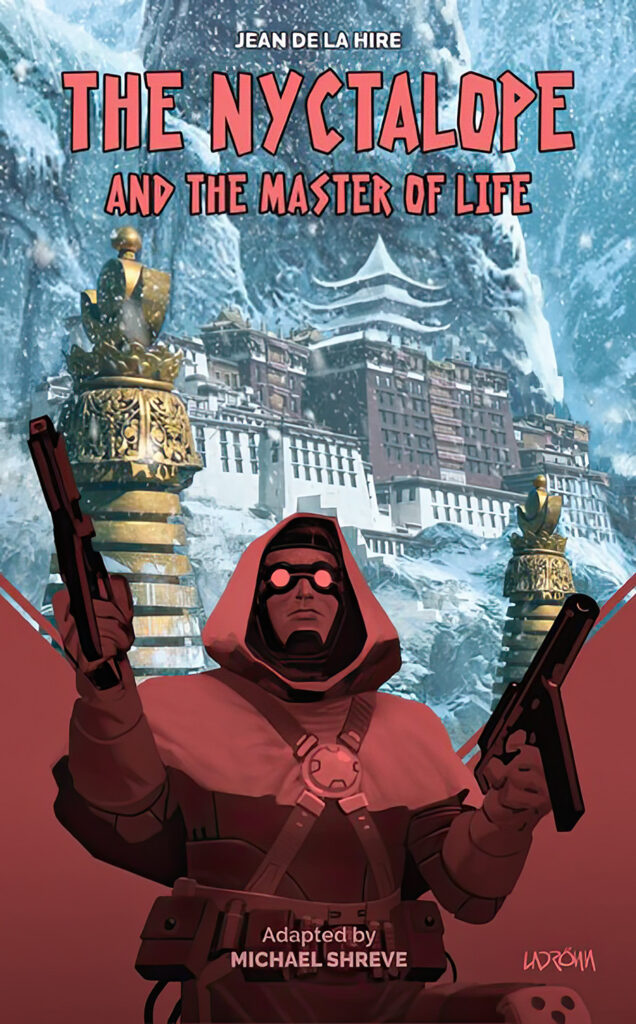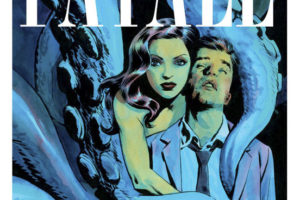The Nyctalope is an overlooked French proto-superhero/proto-pulp adventurer that was featured in a series of serialized novels and stories by Jean de La Hire during the first half of the 20th century.
 Due in part to the author working with the Vichy French government during World War II, both he and his character fell out of popularity.
Due in part to the author working with the Vichy French government during World War II, both he and his character fell out of popularity.
Black Coat Press has been slowly bringing back the character in translations of the original stories and in new ones by several authors in their Tales of the Shadowmen series.
There has been an attempt to fit all these stories into a coherent chronology, and explain or fix some of the problems in the original stories. They have put out seven volumes with the original Nyctalope novels and stories, along with new stories.
Now I look at the latest volume, The Nyctalope and The Master of Life, which has a previously unknown story that was never reprinted after it first appeared. So this volume has a nice intro on The Nyctalope, as well as an updated bibliography of the character, and includes a listing of associated works by de La Hire.
The Nyctalope is really Léo Saint-Clair. He has the ability to see in the dark, hence his name. He also has an artificial heart, which seems to also gives him vitality and a bit of longevity. (Though not mentioned in the first novel, this is something the author added later to the character in the origin written much later.)
He embarks on a life of adventure, both on the Earth and on other worlds, and as a patriotic Frenchman, he sets up an independent crime-fighting organization, C.I.D., and works as a sort of independent special agent.
He has several associates who work with or for him. Notable is his two Corsican assistants, Vitto and Soca, and the Japanese baron Gno Mitang, all of whom joined him with the fourth story.
The stories in this series are:
- “Le Mystère des XV” (“The Mystery of the XV”) (1911) — first adventure, translated as The Nyctalope on Mars
- “Lucifer” (1921–22) — translated as Nyctalope vs. Lucifer
- “L’Amazone du Mont Everest” (“The Amazon of Mount Everest”) (1925)
- “La Captive du Démon” (“The Demon’s Captive”) (1927) — to be translated as Nyctalope vs. The Antichrist
- “Titania” (1928)
- “Belzébuth” (1930)
- “Gorillard” (1931-32)
- “Les Mystères de Lyon” (“The Mysteries of Lyon”) (1933)
- “L’Assassinat du Nyctalope” (“The Assassination of The Nyctalope”) (1933) — translated as Enter The Nyctalope, his “origin”
- “Le Sphinx du Maroc” (“The Moroccan Sphinx”) (1934)
- “La Croisière du Nyctalope” (“The Nyctalope’s Cruise”) (1936)
- “Le Maitre de la Vie” (1938-39) — translated as Nyctalope and The Master of Life
- “Le Mystère de la Croix du Sang” (“The Mystery of the Cross of Blood”) (1941) — translated in The Nyctalope and the Tower of Babel.
- “Les Drames de Paris” (1941)
- “Rien qu’une Nuit” (“Only One Night”) (1941) — translated in Night of The Nyctalope
- “L’Enfant Perdu” (“The Lost Child”) (1942) — translated in The Nyctalope Steps In
- “Le Roi de la Nuit” (“The King of the Night”) (1943) — translated in The Return of The Nyctalope
- “La Sorcière Nue” (“The Naked Sorceress”) (written c. 1940+; publ. 1954)
- “L’Énigme du Squelette” (“The Enigma of the Skeleton”) (written c. 1940+; published 1955)
This is actually a corrected list from this book. Also, the list there shows that most of these stories were serialized in the paper Le Matin, some being reprinted in book form, but not all. This affects the writing as such serialized stories drag a bit, and as the readership was mainly female, there can be a bit more romantic elements that most would like. Heck, two couples in the story get married. So be warned.
I also have a problem with folks pushing the idea of The Nyctalope as being an early or even a proto-superhero. I see very few superhero elements. He doesn’t have a costume or a true alter ego. Being known as “The Nyctalope” is more a nickname and is not a secret identity. And I don’t recall that his ability to see in the dark was used much in the stories, nor do I recall his mechanical heart, obtained in his origin story that was given much later, was ever mentioned in the later stories. So when I was reading this latest story, I decided to watch for any of this and note it.
While this story was serialized in 1938-39, it is set in 1937. It should be pointed out that the world was moving quickly to war. Japan had invaded China that year, and Germany annexed Austria in 1938. While several countries are named, no mention is made of either Germany or Italy. And a Japanese is a major character in this story, but nothing is said of Japan’s invasion of China until much later in the work.
Things start off slowly when The Nyctalope is informed that 14 condemned prisoners in prisons across several countries all died of cerebral hemorrhages. Then an opposition politician in Spain dies. And then the British Viceroy of India.
The Nyctalope and his friend Gno speculate that someone with this ability is testing out their powers, maybe under the guidance of another. And Gno relates a tale from Tibet of someone with such a power, and they wonder if this ability has been re-discovered.
Then they get a lead when another man dies, and there are ties to “the richest woman in the world,” and that she was approached by a young woman of mystery named Leone Alzac, who is noted to have a male companion. Can they track these people to the hypothetical “Master of Life”?
Thanks to a few clues, they mount an expedition to a certain lake in Tibet. It will be The Nyctalope and Gno, along with Vitto and Soca, with others handling things in Paris. Those in Paris will be looking for this Leone Alzac and her companion, revealed as a Oryas Zabad Khan, and that will be about half the story, alternating with the storyline in Tibet. The rich woman gets involved with the Irish liberation group, for instance, which complicates things, but is a minor sub plot.
When Leo’s group gets to Uzbekistan, they take on a couple of others: Timor, a Kyrgyz, and Gissa, a former lamasery student. Once at the lake, they spot another party. They find it is a Russian expedition with the Chinese, and it appears the leader is after the secret that the Master of Life may be using.
But when Leo and two others head to the new camp, they find it deserted and signs that the rest of their party, along with the Russians and Chinese, may have been taken by a third group. Leo and his two companions find a lamasery, and run into a British agent, a Colonel Archibald Brown, who had tracked the Russians from Moscow, but who was also captured. But somehow there is a mental barrier that prevents him and others from escaping
Leo finds his companions and goes searching for the “Master of Life,” finding a “Divine Virgin”: Jing Pusa. But what is her connection to Leone Alzac and her companion in Paris? And is she behind the threat, or is it someone else? Can Leo and his friends get to the answer before more die and end the threat?
So, what about his powers (vision and artificial heart)? So during the story his vision was mentioned early on. While driving it was mentioned, but he didn’t rely on it. Then he searched a home with the lights off. Later on, he leads a couple of associates in the dark. His powers were most useful in searching the lamasery at night without a flashlight. But there was never a mention of his heart.
The next planned volume will be Nyctalope vs. The Antichrist, coming early 2024. This one has him going up against Leonid Zattan, Lord of Issyk-Koul, and Red Princess Diana Ivanovna Krasnoview. It’s also the story where he meets Gno Mitang and his young ward, Sylvie Mac Dhul, whom he marries and will have a son. And here he creates C.I.D., his private crime-fighting organization, and also gets two Corsican bodyguards, Vitto and Soca. So a lot of important things happen here.
I should also mention that the YouTube channel “Fizz Fop” did a video on The Nyctalope as I was reading the book. It’s an ok video, with some good original artwork by “Fizz Fop”, but it was marred by relying too much on the Wikipedia article instead of actually reading the stories or clearly noting the work done by Black Coat Press to bring back this character. This is a criticism I have with folks who read articles on pulp characters on Wikipedia which give a bare minimum about the character instead of actually reading the stories of the characters (much easier nowadays) and somehow think they are knowledgeable on the characters.




Your comments